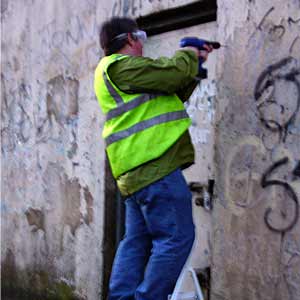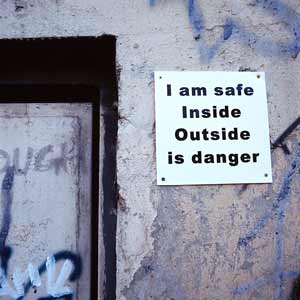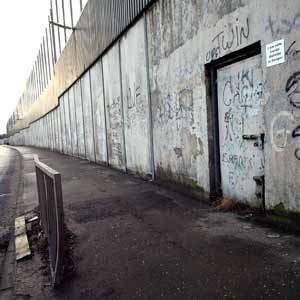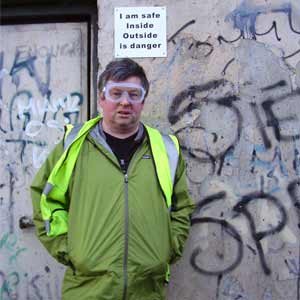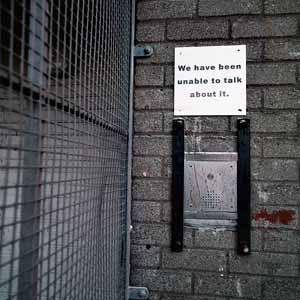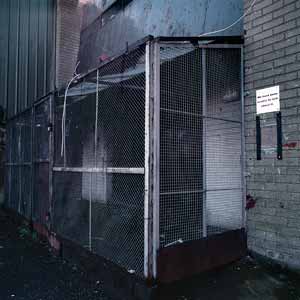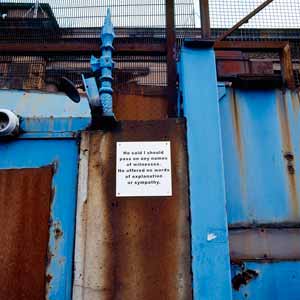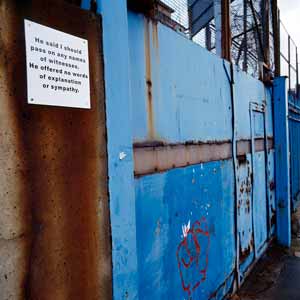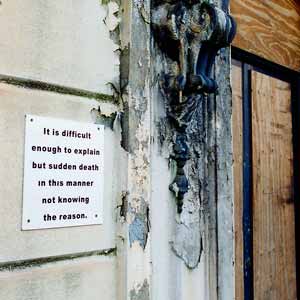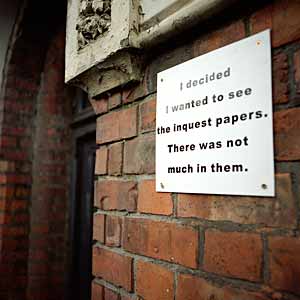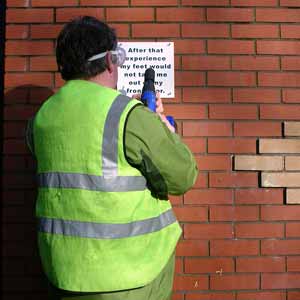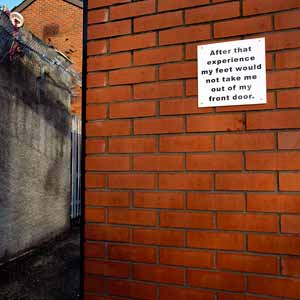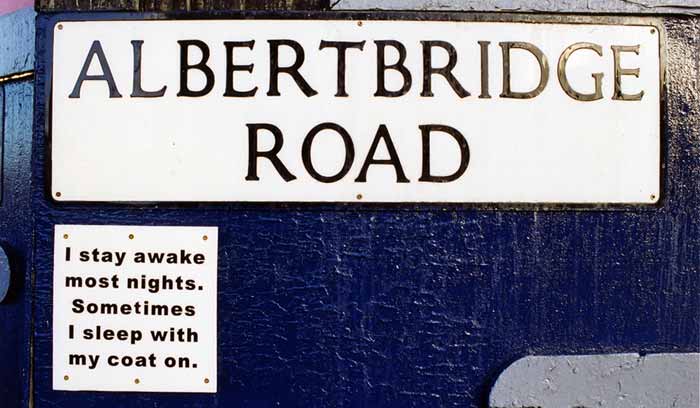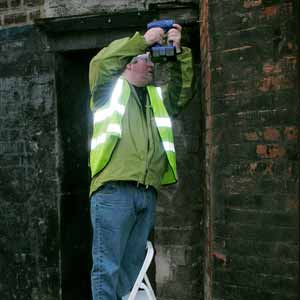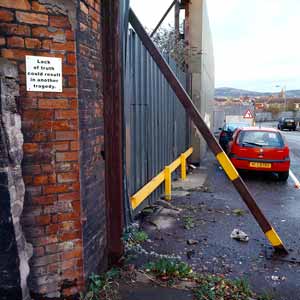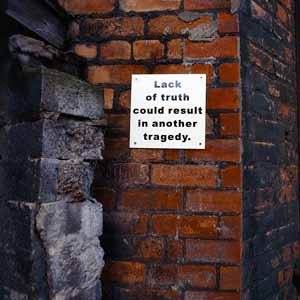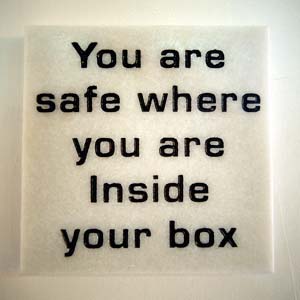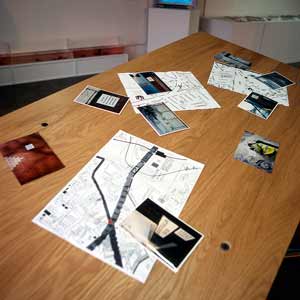2006: Belfast Memories
Scroll down to see all other images
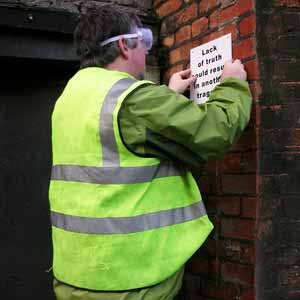
Belfast Memories (2006) was my contribution to an exhibition in Belfast at the Switch Room galleries entitled ‘I confess that I was there…’ This was a group exhibition that took place in November and December 2007. I was invited to contribute by Anthony Haughey and Declan McGonagle.
Belfast Memories (2006) as in Dublin Memories I sited texts in specific sites and referred to each of these site specific works within a gallery space where they would coalesce into a narrative about experience and place. A specific work was also produced for the gallery space that would extend the meanings of the other works. A text based brochure was also produced that combined fragments of text that originated in a number of interviews. This brochure was placed into the gallery space and into specific locations in the commercial areas of Belfast City. The Belfast Memories 2006 brochure can be read here »
The work I produced for ‘I confess that I was there …’ had its roots in an earlier project that I produced in 2002 for an exhibition entitled ‘Perspective 2002’ for the Ormeau Baths Gallery. This work was similar to the Dublin Memories project that had been shown in the Hugh Lane Gallery earlier that year. The main difference was that the deadline for the work was considerably shorter in that Dublin Memories was the fruit of two years research and hard work. Belfast Memories was the fruit of just over two months’ research and very hard work. There was also no budget available for this project either. However despite these difficult constraints I had done extensive research in the form of recorded interviews with over thirty Belfast people. I drew upon these interviews in producing the work for Belfast Memories (2006).
The title, ‘I confess that I was there…’ with its first person singular address and testimonial overtones seemed very appropriate to my earlier project. For Belfast Memories (2006) I decided I wanted to give the project more focus than the earlier Belfast Memories work. I decided that my focus would be on personal trauma, unresolved feelings and other issues that came from experiencing violence directly, or through the loss of a loved one or as a witness to violence.
I used some of the interviews I recorded in 2002 as reference for the new work. These would have included interviews with Jim McCabe at ‘Relatives for Justice’, with Danny Devaney and neighbours from the Short Strand and Mina Wardle of ‘The Shankill Stress and trauma Group’. I also did interviews with Claire Hackett, coordinator of the ‘Duchas Living History Project’ and chair of the storytelling group of ‘Healing through Remembering’ and Ray Mullens of ‘The Community Relations Council’. They both gave me specific information relating to trauma and the context of post-ceasefire Belfast.
By carefully working the original transcripts I developed a series of short texts that originated in communities on opposite sides of the conflict. Texts were created that had the detail of a specific incident and were evocative of the aftermath of violence and the burden it creates in the victim’s life. Details regarding the identity of the voice were removed leaving instead a fragment about an experience of innocent victimhood. I met many people in Belfast struggling not to be defined by such experiences. This trauma or wound is fairly common in post cease fire Belfast and comes from violence that has created division and fear throughout the society. The damage is manifest in the private lives of courageous people I recorded who told me of phobias, depression and all the symptoms of post-traumatic stress disorder. These symptoms if left untreated can blight the lives of those who suffer from them and their relationships to their families, friends and communities.
I was told of these difficulties by the people I recorded in 2002 and I intended my texts to register them. I wrote up a series of short direct texts based on the recordings and about the aftermath of violence. ‘I am safe inside Outside is danger’, ‘I stay awake most nights. Sometimes I sleep with my coat on.’, ‘After that experience my feet would not take me out of my front door’. Then there is the experience of not being listened to, of not being acknowledged, ‘We have not been able to talk about it’, ‘He said I should pass on any names of witnesses. He offered no words of explanation or sympathy.’ In a number of interviews there is a sense of confusion, meaninglessness and frustration, ‘It is difficult enough to explain but sudden death in this manner not knowing the reason’, ‘I decided I wanted to see the inquest papers. There was not much in them.’ There are also consequences to not resolving all the issues, ‘Lack of truth could result in another tragedy’.
At first I thought each sign would be site specific however upon cycling around Belfast looking for possible sites I found myself drawn to the peace lines and peace walls that cut through many parts of Belfast city. These mute structures which are a part of the built environment in Belfast seem to embody blockages in communication whilst dividing parts of the city along lines of ethnicity. Each peace wall has an entrance leading to the other side. Sometimes these are permanently locked or are open only at specific times during the day. I decided to site my texts predominantly at these entrances (see images below). I also sited a group of texts as a cluster around the Crumlin Road. This siting arrangement added an element of spatial fiction to this work.
The texts were then made into white PVC signs. The typography was self-consciously bland so as to suggest everyday official signage. I installed each sign personally using three inch screws, a power drill, and the strongest adhesive available (see fig. 1,4,11,14,15). Upon completing the installation each site was photographed (see images below). The film was processed and printed in a standard photographic printers and the results were displayed an informal placing at the Switch Room Galleries. The placing suggesting a spatial mapping of each site (see fig. 19).
I also installed a complementary piece designed especially for the Gallery. The text for this piece was based on an obscure sentence I recorded from an interview in 2002, ‘You are safe where you are inside your box.’ The meaning I intended was that security and safety were being prioritised behind peace walls and fixed positions that impeded any communication and froze any potential development and growth. I also felt it was about the art world as I experienced it in that it seemed to largely restrict itself to the safety of the white cube. The sign in this case was made from white marble of a type that may be used to manufacture grave stones (see fig. 18).
The printed brochure workwas also made available in the Gallery. It was also distributed as a free publication in various venues in Belfast City.
Thanks to Doris Rohr for accompanying me and taking photos of the work being installed (fig. 1,4,11,14,15). Thanks to Anthony Haughey and Declan McGonagle for curating the exhibition and for support throughout.
Chris Reid 1.9.2014
.
Click on images to enlarge

